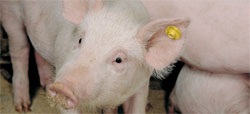



Swine Fever (Classical and African)
An overview of the signs of Classical Swine Fever and African Swine Fever from the Department of Agriculture and Food in Western Australia. |
Classical swine fever and African swine fever are both highly contagious viral diseases, affecting only pigs. The diseases are similar, although they are caused by different viruses.
A chronic form of classical swine fever was sucessfully eradicated from Australia in 1962 after waste from ships was fed to pigs. African swine fever has never occurred in Australia.
The most likely way that these diseases would enter Australia is via feeding illegally imported pig meat or other pig products to pigs. Both diseases occur in many pig-producing countries, including those in Southeast Asia.
What are the signs of classical and African swine fever in pigs?
Signs of acute swine fever include:
- fever and loss of appetite
- skin reddening
- blueness of extremities (including ears)
- coughing and difficulty breathing
- diarrhoea
- vomiting
- abortions
- sudden increase in deaths.
Chronic forms of classical swine fever result in milder signs and may be hard to distinguish from common diseases.
Why should I report classical and African swine fever signs?
Both diseases are reportable in all states of Australia. This means that if you suspect that your pigs have signs of classical or African swine fever, you must report this to a veterinarian or to a Department of Agriculture and Food veterinarian.
Because the signs of both diseases are similar to each other and to more common endemic diseases, it is important to ensure that a veterinarian always investigates increased deaths and/or increases in the incidence of any of the above signs.
Detecting the disease early will reduce its spread and make it easier to eradicate.
If you see signs similar to swine fever in pigs, contact your veterinarian or the Emergency Animal Disease hotline on 1800 675 888.
How would classical or African swine fever enter Australia?
The most likely way that these diseases would enter Australia is via feeding illegally imported pig meat or other pig products ('swill feeding') to pigs. Both viruses can survive in pigmeat products for extended periods.
Swill feeding of pigs is illegal in Australia.
How do the swine fevers spread?
The disease spreads between pigs through contact with faeces, urine and other discharges or through use of contaminated equipment, vehicles and clothing.
Ticks can also spread African swine fever.
How can I reduce the risk of swine fever occurring on my property?
Routine biosecurity measures should be in place on all piggeries:
- newly introduced or returning stock held in quarantine for at least seven days
- minimising visitors and visitor log book
- visitors to wear clean boots and overalls and not be in contact with other pigs for a minimum of 12 hours
- not feeding swill to pigs
- perimeter fencing to prevent contact with feral pigs.
Monitor pigs daily and report signs of illness or deaths to a veterinarian.
August 2014








